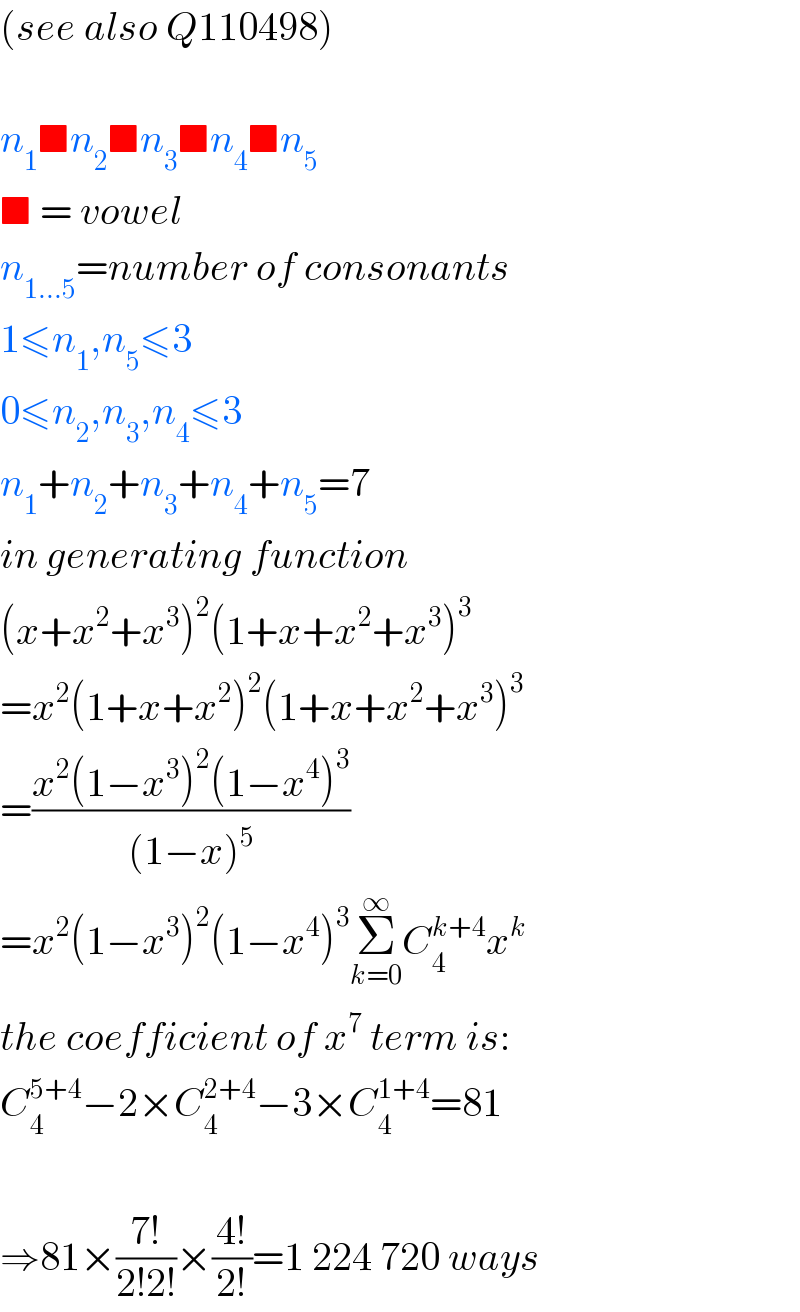
Previous in Permutation and Combination Next in Permutation and Combination
Question Number 110729 by mr W last updated on 30/Aug/20

$$\mathrm{How}\:\mathrm{many}\:\mathrm{ways}\:\mathrm{can}\:\mathrm{the}\:\mathrm{letters}\:\mathrm{in} \\ $$$$\mathrm{the}\:\mathrm{word}\:\boldsymbol{\mathrm{MATHEMATICS}} \\ $$$$\mathrm{be}\:\mathrm{rearranged}\:\mathrm{such}\:\mathrm{that}\:\mathrm{the}\:\mathrm{word} \\ $$$$\mathrm{formed}\:\mathrm{neither}\:\mathrm{starts}\:\mathrm{nor}\:\mathrm{ends}\:\mathrm{with}\:\mathrm{a}\: \\ $$$$\mathrm{vowel},\:\mathrm{and}\:\mathrm{any}\:\mathrm{four}\:\mathrm{consecutive}\: \\ $$$$\mathrm{letters}\:\mathrm{must}\:\mathrm{contain}\:\mathrm{at}\:\mathrm{least}\:\mathrm{a}\:\mathrm{vowel}? \\ $$
Answered by mr W last updated on 30/Aug/20

$$\left({see}\:{also}\:{Q}\mathrm{110498}\right) \\ $$$$ \\ $$$${n}_{\mathrm{1}} \blacksquare{n}_{\mathrm{2}} \blacksquare{n}_{\mathrm{3}} \blacksquare{n}_{\mathrm{4}} \blacksquare{n}_{\mathrm{5}} \\ $$$$\blacksquare\:=\:{vowel} \\ $$$${n}_{\mathrm{1}...\mathrm{5}} ={number}\:{of}\:{consonants} \\ $$$$\mathrm{1}\leqslant{n}_{\mathrm{1}} ,{n}_{\mathrm{5}} \leqslant\mathrm{3} \\ $$$$\mathrm{0}\leqslant{n}_{\mathrm{2}} ,{n}_{\mathrm{3}} ,{n}_{\mathrm{4}} \leqslant\mathrm{3} \\ $$$${n}_{\mathrm{1}} +{n}_{\mathrm{2}} +{n}_{\mathrm{3}} +{n}_{\mathrm{4}} +{n}_{\mathrm{5}} =\mathrm{7} \\ $$$${in}\:{generating}\:{function} \\ $$$$\left({x}+{x}^{\mathrm{2}} +{x}^{\mathrm{3}} \right)^{\mathrm{2}} \left(\mathrm{1}+{x}+{x}^{\mathrm{2}} +{x}^{\mathrm{3}} \right)^{\mathrm{3}} \\ $$$$={x}^{\mathrm{2}} \left(\mathrm{1}+{x}+{x}^{\mathrm{2}} \right)^{\mathrm{2}} \left(\mathrm{1}+{x}+{x}^{\mathrm{2}} +{x}^{\mathrm{3}} \right)^{\mathrm{3}} \\ $$$$=\frac{{x}^{\mathrm{2}} \left(\mathrm{1}−{x}^{\mathrm{3}} \right)^{\mathrm{2}} \left(\mathrm{1}−{x}^{\mathrm{4}} \right)^{\mathrm{3}} }{\left(\mathrm{1}−{x}\right)^{\mathrm{5}} } \\ $$$$={x}^{\mathrm{2}} \left(\mathrm{1}−{x}^{\mathrm{3}} \right)^{\mathrm{2}} \left(\mathrm{1}−{x}^{\mathrm{4}} \right)^{\mathrm{3}} \underset{{k}=\mathrm{0}} {\overset{\infty} {\sum}}{C}_{\mathrm{4}} ^{{k}+\mathrm{4}} {x}^{{k}} \\ $$$${the}\:{coefficient}\:{of}\:{x}^{\mathrm{7}} \:{term}\:{is}: \\ $$$${C}_{\mathrm{4}} ^{\mathrm{5}+\mathrm{4}} −\mathrm{2}×{C}_{\mathrm{4}} ^{\mathrm{2}+\mathrm{4}} −\mathrm{3}×{C}_{\mathrm{4}} ^{\mathrm{1}+\mathrm{4}} =\mathrm{81} \\ $$$$ \\ $$$$\Rightarrow\mathrm{81}×\frac{\mathrm{7}!}{\mathrm{2}!\mathrm{2}!}×\frac{\mathrm{4}!}{\mathrm{2}!}=\mathrm{1}\:\mathrm{224}\:\mathrm{720}\:{ways} \\ $$
